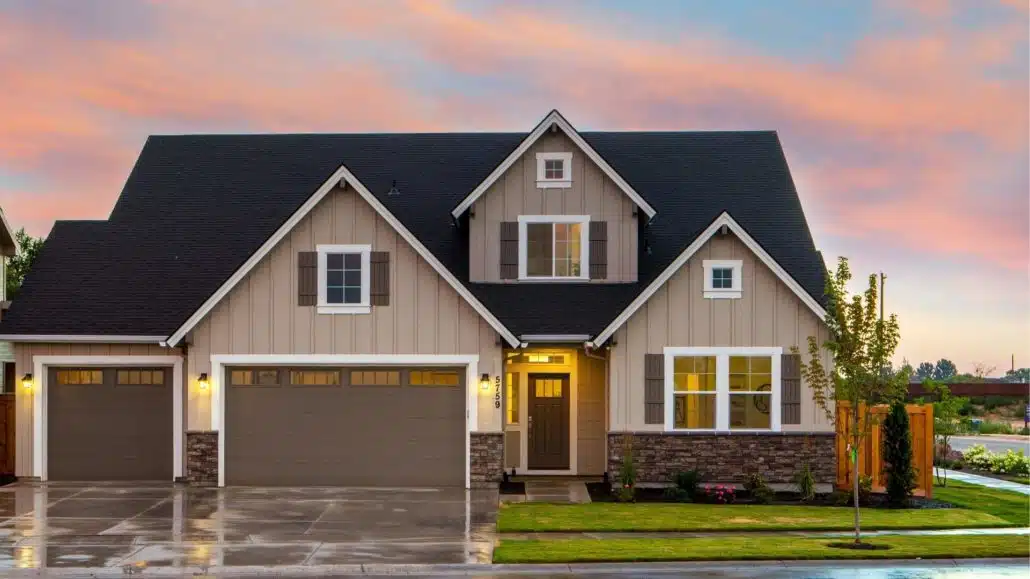If you’re thinking about painting the exterior of your home, there’s no doubt that you want the new look to last.
But what factors determine how long a paint job will last? Are certain colors better than others when it comes to fading? Is there a type of paint that can handle the harsh Portland weather?
If you’re wondering how long exterior paint lasts, we’ll fill you in by looking at:
- Factors that contribute to exterior paint lifespan
- Types of paint used in exterior paint jobs; and
- Tips to get the most life out of your exterior paint
Table of Contents
- How Long Does Exterior Paint Last?
- 3 Factors That Contribute to Exterior Paint’s Lifespan
- 4 Tips for Getting the Most Out of Your Exterior Paint’s Life Expectancy
- We Do the Job Right at Two Brothers Painting: #1 Exterior Painters in the Greater Portland Area
How Long Does Exterior Paint Last?
It goes without saying that none of us wants to paint the exterior of our home more than we need to. It’s a huge job.
We want to know that our home’s exterior paint job is going to last, and most exterior paint jobs can last from ten to twenty-five years.
All that said, determining exterior paint life depends on several factors, including:
- Paint grade
- Paint color; and
- Building material
3 Factors That Contribute to Exterior Paint’s Lifespan
All paint is not the same.
Paints differ in …
- Grade
- Color; and
- Finish
… among other things.
And when considering how long exterior paint lasts, the surface of the building being painted also has a lot to do with how long the paint will adhere.
Let’s take a look at some of these factors to help determine which type of paint will give you the longest-lasting result.
#1: Paint Grade
There are all kinds of paints to choose from when painting your home’s exterior, but most of those exterior paints can be broken up into three categories:
- Builder Grade
- Middle Grade
- Upper Grade
The reality is that it’s difficult to tell different grades of paint apart just by looking at them. But don’t be fooled; the grade of paint used for exteriors is a big deal, and choosing the right one is crucial to know how long a paint job should last on a house.
The grade of exterior paint is determined by the following factors:
- How it’s manufactured
- The quality of the binders
- The quality of resins
- The type of pigments used (bulk pigments vs. prime pigments like titanium dioxide)
Builder Grade
Builder-grade paint is poor quality paint that doesn’t hold up because it tends to:
- Peel
- Fade; and
- Chalk
If builder-grade paint is so bad, you may wonder why anyone would even consider using it.
It’s a cheap alternative, and that saves builders and homeowners money right away — but not in the long run.
Choosing builder grade paint may mean:
- It’s more difficult to apply
- It may not hide imperfections on the surface
- Fading and chipping that leaves a less than attractive look over time
Moving up just one grade can give better and longer-lasting results.
Middle Grade
A giant leap above builder-grade paint is middle grade paint. With a 25-year warranty, ideally, middle-grade paint should last for that amount of time.
Middle-grade paints tend to provide greater coverage, color retention, and durability.
Two Brothers Painting generally uses middle-grade paint because …
- It provides durable and long-lasting coverage at an affordable price; and
- Most customers want to repaint their homes within ten years (not twenty or thirty)
… so choosing paint with a much longer warranty means you may be paying a higher price than you need to.
Upper Grade
Upper-grade paints usually come with a lifetime warranty.
Most people want to repaint their homes within ten years either because of wear and tear or because they want a fresh look or new color. Paying the extra price for upper-grade paint just doesn’t make sense for those who want to freshen up or have a change in color from time to time.
However, if you are not in the majority and want a once-and-done paint job — one you’ll never have to paint again — an upper grade paint may be the best choice.
No matter what type of home you live in, Two Brothers Painting can help. We’ll schedule a time to meet to provide a free estimate, and should you choose us, we’ll deliver a paint job of quality and beauty.
#2: Paint Color
Paint color is an important aspect when considering exterior paint lifespan.
In general, brighter and darker hues fader more quickly than lighter shades.
Darker colors:
- Absorb more heat than lighter colors
- Tend to have more problems with moisture
- Fade more quickly, making touch-ups nearly impossible
On the other hand, light shades:
- Absorb less heat
- Have fewer issues with moisture
- Resist fading; and
- May add up to five years to the life of your exterior paint
Light shades like …
- Earth tones
- Browns
- Beiges
- Whites
… are made with inorganic pigments that break down more slowly than colors like …
- Reds
- Greens
- Blues; and
- Yellows
… that are made with organic pigments that break down more quickly.
#3: Building Material
Lastly, the type of material being painted over can help in knowing how long the exterior paint will last.
Homes and businesses come in all types of exteriors, including:
- Wood siding
- Stucco
- Aluminum siding
- Vinyl siding
- Brick; and
- Modern materials like cement fiberboard siding
Other factors must be kept in mind when considering the lifespan of exterior paint (climate, weather, sun exposure, etc.), but when thinking about the type of home or business exterior to be painted, these timelines may be helpful:
- Aluminum siding may need repainting every five years.
- Wood siding may need repainting every three to seven years.
- Stucco may need repainting every five to six years.
- Brick may need to be repainted every fifteen to twenty years.
You can trust Two Brothers Painting to choose the best paint for your particular home and to paint your home with the expertise that comes with a combined 145 years of experience.
We paint every Portland Metro home like it’s our own.
4 Tips for Getting the Most Out of Your Exterior Paint’s Life Expectancy
Other than choosing middle-grade paint, follow these tips to extend the life of your exterior paint.
#1: Don’t Skimp on Prep
Prep work may sound like it should be easy and can be skipped, especially if you’re the impatient type and just want to get to the finished product ASAP. But prep work is undeniably the most important part of any paint job.
In reality, prep work can make up 80% of the entire painting job, so leaving out some of the prep work can have devastating results, making the job take longer and costing more in the long run.
Don’t skimp on prep work like:
- Power washing
- Caulking
- Scraping
- Sanding; and
- Priming
The right kind of prep work for exteriors means that the paint will adhere correctly without peeling or cracking, leaving a professional look and exquisite curb appeal.
#2: Use Quality Primer
A good primer will ensure the paint adheres to the surface and will also extend exterior paint lifespan.
The best primer for the job will depend on the surface being painted. For wood surfaces, an oil-based primer is recommended.
For masonry surfaces like brick and concrete, painters need to take two factors into account when choosing the right kind of primer:
- Efflorescence – A fine, white powder left on masonry surfaces as water evaporates that can be removed by pressure washing before applying masonry primer
- pH level – Levels can be high when dealing with masonry which makes it harder for the paint to adhere. Masonry primer covers the range of pH levels on a surface ensuring even paint coverage.
No matter what surface you are painting on, a quality primer will act as a first coat, allowing the paint to adhere, and will resist bubbling and cracking for a pristine, professional look.
#3: Choose High-Quality Paint
It naturally follows that high-quality paint should be used over a high-quality primer.
Most professional painters agree that high-quality or premium acrylic latex paints are the best for exterior paint jobs. Here’s why:
- Versatility – Acrylic latex paints can be used over both water- and oil-based primers.
- Longevity – As opposed to oil-based paints, acrylic paints resist hardening, which helps to resist blistering and mildew.
- Maintenance – Acrylic paints are easier to clean and maintain than oil-based paints.
#4: Apply Paint the Right Way
Everyone is about saving money and resources where we can, but skimping on the amount of paint used for an exterior job is not the place to cut corners to save a few bucks.
A thick coat is needed to get full coverage that will last. Following the manufacturer’s spread rate is the best place to start.
For example, a 2000-square-foot house should take 25-30 gallons of paint (depending on the siding). But some painters attempt to do the same job with as little as 10 gallons of paint. They do this by using two coats, which is what manufacturers recommend. But these two coats are light or are being done with a smaller tip. Either way, the coats are too light and don’t provide the millage (the thickness of paint film once it dries down) necessary for long-lasting coverage.
The rule of thumb is to go through the gallonage according to the manufacturer’s spread rate. If an exterior paint job is done correctly, you’ll want to paint the house simply to change colors long before the quality fades.
You can trust our experienced painters at Two Brothers Painting to choose the best primers and paint for your surface. We’ll focus on quality and durability when choosing the paint that will be perfect for your wood, stucco, or brick surface.
We Do the Job Right at Two Brothers Painting: #1 Exterior Painters in the Greater Portland Area
You can trust Two Brothers Painting to paint your exterior the right way. With over 145 years of combined experience, we have the wisdom and know-how when it comes to:
- Prep work
- Primer and paint choice; and
- Application
You’ll get a quality job with a professional finish.
Because we live and work in the Portland Metro area, we know how brutal the weather can be, causing such problems as:
- Peeling
- Mildew
- Vinyl warping
- Fading; and
- Lapping
We know how to identify existing problems and apply the right solution for your wood, stucco, vinyl, or brick home.
Call us today or schedule an estimate online to take the first step toward a new look for the exterior of your home.





